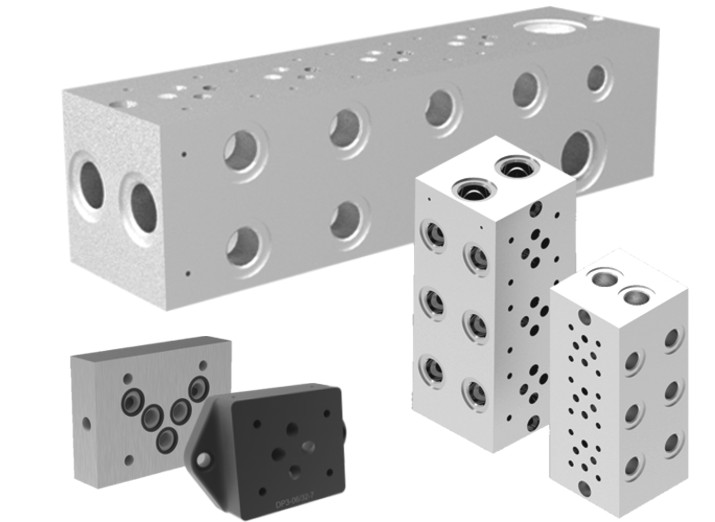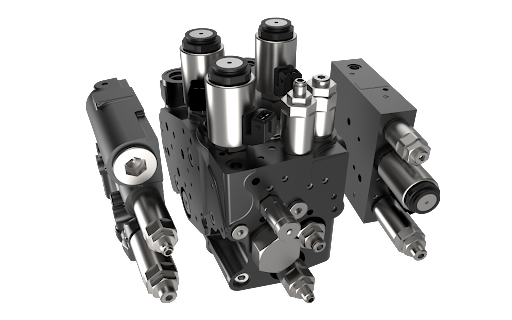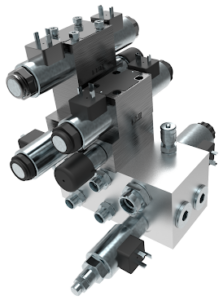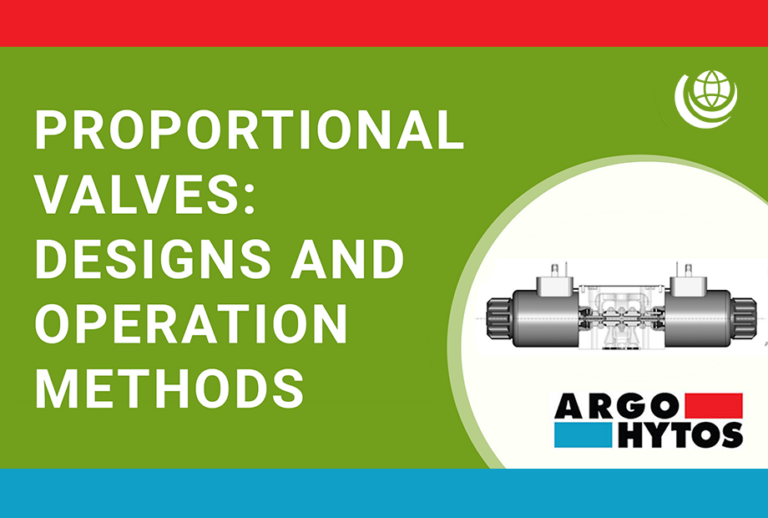Hydraulic manifolds consist of a large number of integrated valves – such as pressure relief valves, directional control valves and pressure control valves – housed in a single casing. This compactness aids assembly, reduces leakage points and enables optimized hydraulic flow.
In this article, reproduced with kind permission from ARGO-HYTOS, we look in detail at the technical properties of manifolds and the various industrial and mobile hydraulic applications that use them. Read on to learn how these high-precision components significantly influence the operation and performance of machines and systems.
What are the main technical characteristics of manifolds?
Manifolds offer many advantages that make them an ideal choice for a wide range of applications. Their space-saving design makes them easy to install and ideal for confined spaces. For larger nominal sizes, they allow compact control with minimal sealing points. This reduces susceptibility to leakage and increases system reliability and tightness. Their sophisticated design results in small installation dimensions, which facilitates assembly, saves space, and increases overall system efficiency.
Manifolds meet high requirements for safety, tightness and functionality. They thus increase the efficiency and performance of machines and systems by enabling precise control and regulation of the hydraulics. In this way, the components also help to reduce the maintenance that is needed together with operating costs.
The ability to develop customer-specific solutions comparatively easily and quickly makes manifolds even more attractive. They can be optimally adapted to the needs of different projects.

ARGO-HYTOS offer a variety of modular valve systems and can support specific requirements with an attractive price-performance ratio. The modular systems offer a wide range of standardized valves, connections and accessories. Thus, a flexible and modular configuration for each individual application is made possible.
Due to their use of high-quality materials and state-of-the-art manufacturing techniques, manifolds from ARGO-HYTOS withstand even high stresses and loads. A long service life and high reliability are thus guaranteed. The material selection of steel, cast iron and aluminum is matched to the respective requirements and areas of application.
Steel offers excellent strength properties and is suitable for high pressures up to 420 bar. Cast iron ensures a good balance of strength and cost efficiency for similar pressure ranges. Aluminum is lighter and suitable for applications with pressures up to 250 bar.
Various types and designs of manifolds
Hydraulic manifolds are available in various designs and versions to meet a wide range of requirements and conditions.
Depending on the area of application and specific requirements, the following designs can be used:
- Monoblock: Monoblocks are made from a single piece and provide a compact and robust solution. They are ideal for applications with limited space and are particularly suitable for smaller systems.
- Connecting plates or control plates: This design allows easy mounting of valves and connections directly on the plate. It offers a flexible and modular solution for hydraulic control and can be extended or adapted according to requirements.
- Longitudinal or vertical interlinking: In these designs, valves and connections are interlinked either longitudinally or vertically. Interlinking setups allow optimized arrangement of the valves and efficient use of the available space.
Depending on the pressure requirements and application area, different materials are used for ARGO-HYTOS manifolds:
- Steel manifolds are suitable for pressures up to 420 bar. They offer high strength and resistance to corrosion and wear.
- Cast iron manifolds can also handle pressures up to 420 bar and are a cost-effective alternative to steel.
- Aluminum manifolds are designed for pressures up to 250 bar. They have the advantage of lower weight and high corrosion resistance.
Design characteristics
Short and compact; the characteristics of the different designs are as follows:
- Monoblock: compact, robust, ideal for smaller systems
- Connecting plate/control plate: flexible, modular, expandable
- Longitudinal linking: optimized arrangement, space-saving
- Vertical stacking: efficient use of space, space-saving
- Steel: high strength, pressure resistance up to 420 bar
- Cast iron: cost-effective, pressure resistance up to 420 bar
- Aluminum: light, corrosion resistant, pressure resistance up to 250 bar

Common applications using manifolds
Hydraulic manifolds are used in a variety of industries and applications – in both stationary and mobile hydraulics. The following examples show the versatility of this technology and the advantages it offers in each area:
1. Injection molding machines: In injection molding machines, manifolds are essential to ensure the precise and fast movement of the machine. The compact and flexible characteristics of control blocks allow them to be easily integrated into the machine design. In addition, they meet high requirements for fail-safety and tightness. This is crucial for the efficient control of pressure and temperature in the injection molding process.
2. Metal forming: in hydraulic presses, pumps or accumulators, precise control of pressure and movement plays a crucial role. Here, manifolds offer compact control options with minimal space requirements and low risk of leakage. Their modular design enables customer-specific solutions and easy system expansion or adaptation. The high reliability and functionality of the control blocks contribute to the optimization of production processes and a longer service life of the machines.
3. Metalworking: for sawing and other machine tools, precise control of movement and pressure is required for high quality cuts. Manifolds allow precise control of cutting speed and feed. This results in improved product quality and higher productivity. The ease of installation and small installation dimensions make it easier to integrate the control blocks into the machine design. They also enable efficient use of the available space.
4. Mobile machines: In agricultural, forestry and construction machinery, manifolds are essential for controlling movements and work functions. The control blocks’ robust design and high pressure resistance ensure reliable performance even under extreme conditions. The customized solutions and modular valve systems allow optimum adaptation to the specific requirements of the machine in question. Thanks to their space-saving and easy-to-install design, they can be easily integrated into the vehicle structure. This minimizes maintenance and repair costs.
Typical applications of ARGO-HYTOS manifolds in mobile machinery include:
In agriculture:
Manifolds are used in trailed and self-propelled sprayers to precisely control various boom functions. For example, the control blocks handle height and tilt adjustment, sway, damping, folding in and out, and angling of the boom. In addition, the control blocks provide a locking function for road transport. Depending on requirements, switching valves and/or proportionally controlled valves can be used to ensure optimum control at all times.
In seed drills, manifolds enable precise control of the seeding rate using proportional technology. This ensures uniform and efficient distribution of seed, resulting in high quality seeding.
In balers and wrappers, manifolds are used, for example, to control baling pressure or to perform functions such as tailgate opening and closing, wrapping, turning and centering of the bales. Precise control of these functions helps to process crops efficiently and optimize production processes.
In tractors, central control blocks with a wide range of integrated functions perform a wide variety of tasks. These include volume flow summation, reliable adjustment of the suspension or control of attachments.
In road construction and municipal vehicles:
In blacktop pavers, compaction machines or cold milling machines, ARGO-HYTOS manifolds take over the control of screed functions, brake release devices or vibration drives.
In sweepers or multifunctional equipment carriers – the most typical examples of the wide range of municipal vehicles – hydraulic control blocks are used to take over, among other things, the brakes, the control, the rotation and positioning of the brushes or the control of the attachments.
The importance of manifolds in industry
Manifolds are essential components in a wide range of industrial applications. Due to their compact design, they enable efficient control options with minimal space requirements. ARGO-HYTOS’ modular valve systems and customized solutions offer adaptability and flexibility to meet the requirements of a wide range of applications.
The use of hydraulic control manifolds in injection molding machines, metal forming equipment, metalworking machines, and mobile machinery demonstrates the versatility of this technology. It also makes its contribution to improving the productivity and quality of products and processes. The high reliability, tightness and functionality of the control blocks ensure reliable performance even under demanding conditions. They also help to extend the service life of machinery and equipment.

Please contact our award-winning team for technical advice and configuration options on ARGO-HYTOS hydraulic manifolds – we’ll be delighted to help!
More free educational content from Argo Hytos…
How to use Overcentre Valves Correctly
In the world of hydraulics, overcentre valves provide precise control and regulation of loads. They provide three essential functions in one component: check valve, pressure relief and cavitation protection. This combination enables efficient, safe and powerful handling of hydraulic systems.
Learn MoreProportional Valves: Designs and Operation Methods
Numerous applications and systems require a highly precise adjustment of the pressure and/or the volume flow according to the needs of the particular operating system. This task is performed by proportional valves.
Learn MoreAll you need to know about Pressure Reducing Valves
A pressure reducing valve is used in line or hose systems. Also known as pressure regulating valves, these components regulate high or fluctuating inlet pressures in the system to a predefined outlet pressure. In this way, the valves keep the pressure constant.
Learn More






